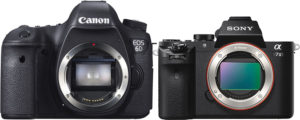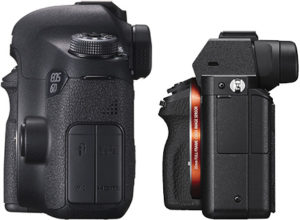Canon EOS 6D vs Sony Alpha A7 Mark II Camera Comparison
When I purchased my Canon EOS 6D in 2015 I went back and forth between it and the Sony Alpha A7 Mark II. Each camera has advantages and disadvantages and ultimately I decided on the Canon 6D simply because I already had lenses, flashes and other accessories. Ever since then I have enjoyed my Canon 6D, other than the size and weight. For the past several months I have been contemplating selling my Canon 6D and getting the Sony A7II to replace it. This Canon EOS 6D vs Sony Alpha A7 Mark II page was created to compare the 2 cameras side by side to help with deciding which camera is best for you (and me).
Side by Side comparison Images
Canon EOS 6D Pricing*
- Canon EOS 6D Body Only - $1999.99
- Canon EOS 6D with EF 24-105mm f/4L IS USM Lens Kit - $2699.99
Check current pricing from these affiliates
Sony Alpha A7 Mark II Pricing*
- Body Only - $1699.99
- Body with 28-70mm f/3.5-5.6 OSS lens - $1999.99
Check current pricing from these affiliates
*Pricing from Manufacturer's website - Current selling price may be different. Be sure to visit the links below for current pricing.
Canon EOS 6D Advantages
Lens Selection
Canon offers a LOT of lenses – pretty much any lens you could ever want (or need) is available from Canon. From standard zoom lenses to exotic telephotos ($10,000 or more) to tilt/shift lenses. This has always been one of the biggest advantages for both Canon and Nikon.
Battery life
Since the Sony is a mirrorless camera it uses an electronic viewfinder that zaps the battery in no time flat. On the Canon I typically get 1,000+ images per battery charge while on my Sony A6000 I’m lucky to get 400 shots on a single battery charge. The Sony A7II battery performance is similar to the Sony A6000.
GPS
The Canon features a built-in GPS unit (as well as an optional hot-shoe mounted version that runs on it’s own batteries). While I don’t use this frequently due to the penalty on battery life, it is nice to have it and being able to see where I shot the images on the map in Lightroom is a nice benefit.
Startup Time
The Canon is pretty much ready to start shooting as soon as it is turned on. The Sony can take up to 2-seconds before it is ready to shoot. On my A6000 I was experiencing an issue where the camera was taking up to 10-seconds before it was ready to shoot. After some research I found that the updated remote app was the culprit. I removed it and the other add-on apps and my start up time was back to a respectible 1.5-2 seconds again, but still not as fast as the Canon.
Low Light Auto focus
This is probably the biggest advantage for the Canon EOS 6D. It can focus in pretty much moonlight. The Sony will hunt when focusing in low light. I do like to shoot after dark, so this is a disadvantage, but that is somewhat offset by the focus peaking and the EVF as you will see in the Sony Advantages below.
Sony Alpha A7 Mark II Advantages
Size & Weight
This is probably the biggest advantage of the A7II over the Canon EOS 6D. I bought my A6000 to use as my “point and shoot” to help offset this difference and I have to admit it is nice to have a small and lightweight camera, but I do miss the full frame aspect of my 6D when I leave it home because it is too big and heavy.
EVF
Even though the EVF is a huge battery drain, I really, REALLY like it. Being able to navigate menus and settings with my eye to the viewfinder is great, but more importantly, when reviewing images in the field it is nice to be able to see them in the viewfinder, especially on sunny days. My aging eyesight isn’t as good as it used to be and not having to break out my reading glasses to see the screen is a bonus. Another nice benefit to the EVF is the exposure simulation and white balance preview as you compose your image. Sometimes it is nice to see the exposure before you shoot and the live histogram is a major boon. Other times having the viewfinder not set to preview the exposure is also helpful as it can be similar to night vision when composing in low light – the EVF gets a boost in light that makes it easier to compose in the dark.
Dual Axis Level
Like many photographers, I suffer from keeping my horizon level when shooting not only hand held, but even on a tripod. The Canon 6D has a built in viewfinder level, but it only shows the “pitch”, not the yaw, and it doesn’t work at all when the camera is turned vertically. The Sony A7II features the dual axis superimposed over the screen that is very easy to see and doesn’t have to be activated separately, nor is it cancelled when you press the shutter button halfway like it does on the Canon.
Tilt LCD
This is not as much as advantage as I would like it to be, I really wish it was fully articulated, but having some adjustment is better than no adjustment at all.
Focus Peaking
In the good old days before auto focus it was somewhat easier to focus manually since the viewfinders of old featured a split prism focusing screen. This gave you a relatively easy way to tell if your shot was in focus. When auto focus was introduced the split finder went the way of the dinosaur and focusing manually became a real challenge. Focus peaking, combined with the auto zoom when focusing manually makes this a lot easier and even somewhat enjoyable. This is a real advantage when combined with adapters for old manual focus lenses that can be had for a dime a dozen used.
Customization of Buttons/controls
If there is one thing that really makes these cameras user friendly it is the plethora of customization to the controls. One of my complaints on my Canon 6D is the lack of a direct “White balance” button. This is a setting I change frequently and having to dive into the menu or the quick menu to change it is tedious. With my A6000 I set the C1 button to be my white balance and I can change it with my eye to the viewfinder to boot.
In-body Stabilization
Until every lens made by a manufacturer is image stabilized it is hard to argue against the benefits of in-body stabilization. The 50mm f/1.8 lenses are typically used in low light where image stabilization is a real advantage, especially when shooting at the longer focal lengths.
Conclusion
At the end of the day the best camera is the one you have with you, which is a compelling advantage for the Sony A7II. That said, if you shoot in low light, or need faster autofocus performance you will be better served by the traditional DSLR, at least at this time, but mirrorless technology is catching up quick, and I am quite certain it is the future of photography. I still contemplate selling my Canon EOS 6D and switching to the A7II, especially since I have the great Sony A6000 that would be a good backup and with the APS-C crop factor, a good lens for telephoto work.
Canon EOS 6D Overall User Rating
4.74 out of 5
based on 1905 user reviews online.
: 81% (1538)
: 15% (289)
: 2% (40)
: 1% (25)
: 1% (14)
Sony Alpha A7 Mark II Overall User Rating
4.41 out of 5
based on 450 user reviews online.
: 66% (295.57)
: 20% (92.07)
: 7% (30.9)
: 3% (13.34)
: 4% (18.12)
Shop
Specs
| Spec | Canon EOS 6D | Sony Alpha A7 Mark II |
|---|---|---|
| Sensor Size | Full Frame | Full Frame |
| Megapixels | 20.2 | 24 |
| Body Construction | Magnesium Alloy and Plastic | Magnesium Alloy |
| Dimensions (WxHxD) | 5.7 x 4.4 x 2.8 in. | 5.0 x 3.8 x 2.4 in. |
| Weight | 1.65 lbs. | 1.22 lbs. |
| Weather Sealed | Yes | Yes |
| Memory Card | SD | SD/SDHC/SDXC |
| Dual Command Wheels | Yes | Yes |
| Viewfinder Type | Pentaprism | Electronic |
| Viewfinder Coverage | 97 | 100 |
| ISO Range | 50-102400 | 100-25600 (Extended: 50-25600) |
| Mirror Lock Up | Yes | Not Applicable |
| Burst Rate | 4.5 fps | 5 fps |
| LCD Size | 3 in. | 3 in. |
| LCD Resolution | 1,040,000 pixels | 1,228,800 pixels |
| Articulated LCD Screen | No Articulation | Tilt Only |
| Touchscreen | No | No |
| Image Stabilization | No | Yes |
| Remote Shutter Release | Wired & Wireless (InfraRed) | Wired & Wireless (InfraRed) |
| WiFi | Yes | Yes |
| GPS | Yes | No |
| AF Points | 11 | 117 Phase Detection / 25 Contrast Detection |
| AF Sensitivity | -3 ev | -1ev - 20ev |
| Minimum Shutter Speed | 30 seconds second | 30 second |
| Maximum Shutter Speed | 1/4000 second seconds | 1/8000 seconds |
| Flash Sync Speed | 1/180 second second | 1/250 second |
| Built In Flash | No | No |
| Wireless TTL Flash | No | No |
| Video Specs | 1920x1080 (Full HD) : 30p/25p/24p 1280x720 (HD): 60p/50p 640x480 (SD): 30p/25p |
1920 x 1080: 60 fps, 30 fps, 24 fps 1440 x 1080: 30 fps 640 x 480: 30 fps |
| Mic In | Yes | Yes |
| Headphone Out | No | Yes |
| Built In Mic | Stereo | Stereo |



